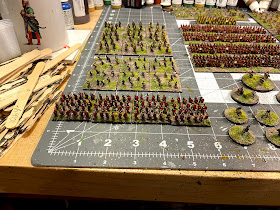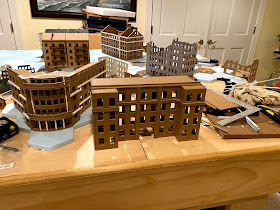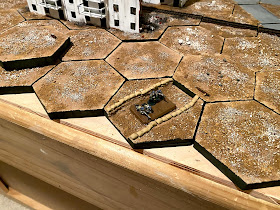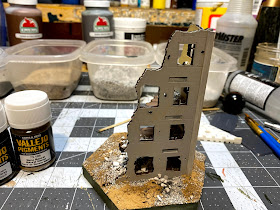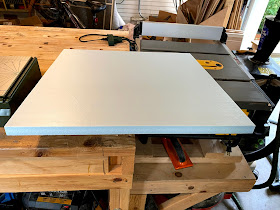Several people have asked "How do you make your hexes" so I thought I would publish a step by step guide. My hexes are sized at 4" across (flat side to flat side) and match the standard used by GHQ.
In order to use the method I'm describing you need 3 tools:
- A hot wire cutting table. I use a proxxon, which is superb but there are other options out there. Don't go cheap on your hot wire table - you use it a lot in terrain making.
- A hex cutting jig - these are not all that hard to make and are required to make precise hexes. How I made my jig can be found this link: Hex Cutting Jig
- A robust straight edge cutting guide - super easy to make and really is the first thing you should add to your hot wire table tool. How I made mine cand be found at this link: Straight Edge Guide
Cautionary Words:
Cutting EPS foam with a hot wire cutter does release toxic gasses which you should NOT breath in. How toxic? I'm no medical expert but have reliable information these fumes are worse than those produced by two day old gas station burritos. Yeah, it's nothing to screw around with. I do my cutting in the garage with the door open and I have a fan behind me blowing the fumes away. Doing so also gives me a wind blow hair look which is a truly glamorous thing to behold. Don't hate me because I'm beautiful.
So without further ado, I present to you :
The Seven Steps to Hex Making Nirvana:
Step1) EPS Foam Prep:
I like to use pink or blue insulation EPS foam panels that are 1 inch thick and 24 by 24 inches in size. Given there is some precision cutting here that's the largest size I can easily manage. I get mine from Amazon in a set of 6 for $35.00. There are cheaper ways to source this material but none that are more convenient. Time is money
Make sure to clean up the material if it's been stored in the open - a few shakes and quick brushing and your ready to go.
A word on dimensions - the thickness of 1 inch is rock solid but the 24 x24 inch sizing is more aspirational - these panels can vary +/- 0.5 inches on the length and width.
Step 2) Set the Guide to 4 inches:
This is the most precise cut you need to make so it's important to take your time.
One of the most valuable tools I have for model making is a set of steel rulers that a have a flat end. These are way more helpful than a standard tape measurer for precise marking.
Step 3A) Make Your First Cut:
Place the EPS foam up against your guide and passi it across. Using a guide is really important - free-hand cutting just ends up with wavy sides.
Friends don't let friends make hexes with wavy lines
Step 3B) Check Your Work:
With the first cut done, double check to make sure the width is 4" inches. Surprisingly, I got this one right.
Once you're sure your at 4 inches go ahead and cut the rest of the material into 4" inch strips - you'll end up with 6 but make sure to keep track of the last one....
Step 3C) Check the Last 4" Strip:
As I mentioned earlier - sometimes these 24 inch panels are actually 24 inches and the one I used was a little short so the 6th strip of foam is only 3 and 3/4 inches wide. This one CAN NOT be used to make hexes so needs to be put aside. It's not really wasted as I'll use the off cuts for other scenery projects.
Step 4) Set the Point to Point Distance:
The next step is to cut they 4x24 inch strips into blocks that are just a tiny bit longer than the hex is point to point. I made up a few 4 Inch (flat to flat) hexes to use a marking guides and use that to set up the cutting cutting guide.
If you want to get into hex terrain having a few of these lying around your shop is really helpful
Once the 4 5/8" cut distance is set cut the 4"x24" strips into 4"x4 5/8 inch blocks. You'll end up with 5 blocks that will make full hexes and one short block that can be used to make hal hexes or be tossed into the "available for future scenery projects bin"
Cut the 4" strips into blocks,
At this point you should have 25 blocks that look like this.
Step 5) Break Out the Hex Jig!
Place one a block in the hex cutting jig and make sure it's firmly seated as shown in the picture to the left.
Make a pass across the wire by pushing the jig forward. Turn the block leaving the first cut on the same side as the cutting wire and pull the jig back across the wire.
Now flip the block so you newly created point faces away from the cutting wire and repeat the two step process above
Wala' you now have a perfect 1" thick hex and four right triangles
Step 6) Set the Guide to 1/2 inch:
We now need to reset the cutting guide to 1/2 inch so we can cut down the 1inch hex into 2 1/2 inch ones. Rather than risk messing up one of our shiny new 1" hexes I test my guide set with one of the triangle cut-offs
They're great to use to test the 1/2 inch setting.
Step 7) Make the Final Cut:
Place the 1 inch thick hex up against the the guide and ....
pass it through the wire (I'm pretty sure you knew that was the next step)
At this point most of you will be doing the happy dance that all hex makers are legally required to perform after their first successful hex. This dance can be physically taxing so make sure to stretch before your performance.
Do that 24 more times. Performing the Hex making dance is really not recommended after each hex as, frankly, most of us are just not in the proper shape to do so.
and boom you've got some hexes! The yield this time was 50 hexes from a 2x2 sheet of EPS foam - sometimes if the foam is cut a little large you can get up to 60.
It took me longer to write up this blog post than to cut 50 hexes. Start to finish the entire cutting process took 33 minutes, which include the time I took to take pictures and added a few minutes to the production time.
There is some foam wastage - I don't find the triangle cut offs all that useful and end up throwing most of them in the bin. I do keep a few as they can make nice braces to pin in place and support a glue up but most, sadly, end up in the bin.
I've been making a lot of hexes.



